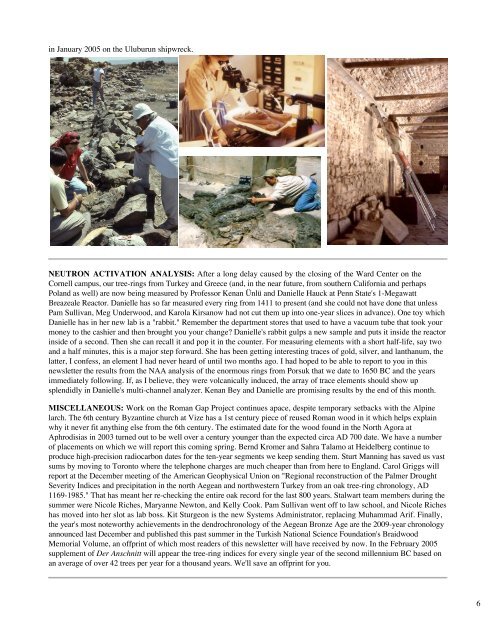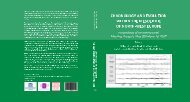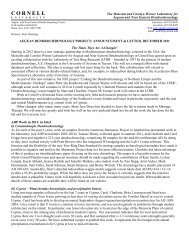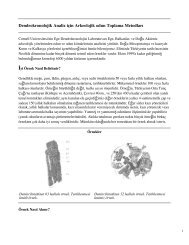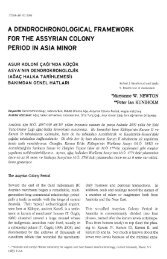Aegean Dendrochronology Project December 2004 Progress Report
Aegean Dendrochronology Project December 2004 Progress Report
Aegean Dendrochronology Project December 2004 Progress Report
You also want an ePaper? Increase the reach of your titles
YUMPU automatically turns print PDFs into web optimized ePapers that Google loves.
in January 2005 on the Uluburun shipwreck.<br />
NEUTRON ACTIVATION ANALYSIS: After a long delay caused by the closing of the Ward Center on the<br />
Cornell campus, our tree-rings from Turkey and Greece (and, in the near future, from southern California and perhaps<br />
Poland as well) are now being measured by Professor Kenan Ünlü and Danielle Hauck at Penn State's 1-Megawatt<br />
Breazeale Reactor. Danielle has so far measured every ring from 1411 to present (and she could not have done that unless<br />
Pam Sullivan, Meg Underwood, and Karola Kirsanow had not cut them up into one-year slices in advance). One toy which<br />
Danielle has in her new lab is a "rabbit." Remember the department stores that used to have a vacuum tube that took your<br />
money to the cashier and then brought you your change? Danielle's rabbit gulps a new sample and puts it inside the reactor<br />
inside of a second. Then she can recall it and pop it in the counter. For measuring elements with a short half-life, say two<br />
and a half minutes, this is a major step forward. She has been getting interesting traces of gold, silver, and lanthanum, the<br />
latter, I confess, an element I had never heard of until two months ago. I had hoped to be able to report to you in this<br />
newsletter the results from the NAA analysis of the enormous rings from Porsuk that we date to 1650 BC and the years<br />
immediately following. If, as I believe, they were volcanically induced, the array of trace elements should show up<br />
splendidly in Danielle's multi-channel analyzer. Kenan Bey and Danielle are promising results by the end of this month.<br />
MISCELLANEOUS: Work on the Roman Gap <strong>Project</strong> continues apace, despite temporary setbacks with the Alpine<br />
larch. The 6th century Byzantine church at Vize has a 1st century piece of reused Roman wood in it which helps explain<br />
why it never fit anything else from the 6th century. The estimated date for the wood found in the North Agora at<br />
Aphrodisias in 2003 turned out to be well over a century younger than the expected circa AD 700 date. We have a number<br />
of placements on which we will report this coming spring. Bernd Kromer and Sahra Talamo at Heidelberg continue to<br />
produce high-precision radiocarbon dates for the ten-year segments we keep sending them. Sturt Manning has saved us vast<br />
sums by moving to Toronto where the telephone charges are much cheaper than from here to England. Carol Griggs will<br />
report at the <strong>December</strong> meeting of the American Geophysical Union on "Regional reconstruction of the Palmer Drought<br />
Severity Indices and precipitation in the north <strong>Aegean</strong> and northwestern Turkey from an oak tree-ring chronology, AD<br />
1169-1985." That has meant her re-checking the entire oak record for the last 800 years. Stalwart team members during the<br />
summer were Nicole Riches, Maryanne Newton, and Kelly Cook. Pam Sullivan went off to law school, and Nicole Riches<br />
has moved into her slot as lab boss. Kit Sturgeon is the new Systems Administrator, replacing Muhammad Arif. Finally,<br />
the year's most noteworthy achievements in the dendrochronology of the <strong>Aegean</strong> Bronze Age are the 2009-year chronology<br />
announced last <strong>December</strong> and published this past summer in the Turkish National Science Foundation's Braidwood<br />
Memorial Volume, an offprint of which most readers of this newsletter will have received by now. In the February 2005<br />
supplement of Der Anschnitt will appear the tree-ring indices for every single year of the second millennium BC based on<br />
an average of over 42 trees per year for a thousand years. We'll save an offprint for you.<br />
6


